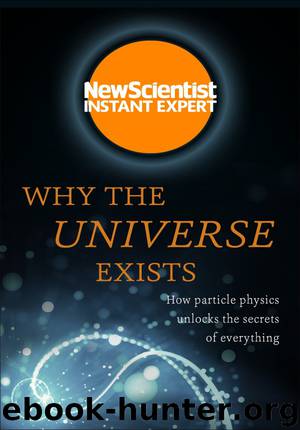Why the Universe Exists by New Scientist

Author:New Scientist
Language: eng
Format: epub
Publisher: Quercus
Published: 2017-07-19T04:00:00+00:00
The propagation of flavours
This is a very quantum phenomenon. In quantum mechanics, one particle can be in a superposition of more than one state – and for neutrinos, it turns out, a state with a well-defined flavour is a blend of three different states with a well-defined mass. The three mass states move at slightly different speeds just below the speed of light, and it’s their precise line-up that determines what flavour is detected when a neutrino is observed. So the three neutrino flavours propagate through space as a constantly changing mixture.
Some grand unified theories, predict neutrinos with mass. Pinning down the precise masses could tell theorists which theory to pursue.
Measuring the mass of a particle that can sail unhindered through a light year of lead is easier said than done, but one way could be measuring radioactive beta decays. In a typical beta decay, a neutron inside an atomic nucleus turns into a proton while spitting out an electron and an electron antineutrino. In theory, the antineutrino’s mass could be inferred from the energy and momentum of the accompanying electron. Neutrinos are so light that it has been impossible to achieve the sensitivity needed, but a sensitive experiment being built at the Karlsruhe Institute of Technology in Germany, called KATRIN, may yet manage it.
Meanwhile, the tightest limits on neutrino mass come from the cosmos, because these particles affect the mix of elements created in the Big Bang and supernovae, the expansion rate of the universe, the cosmic microwave background (CMB), and how matter coalesced into galaxies and galaxy clusters. A combination of the most recent cosmological measurements, including observations of the CMB from the Planck space observatory, reveal that the sum of the three neutrino masses cannot be more than about 0.13 electronvolts (eV) – less than a millionth that of the electron.
Because of their constant shape-shifting, it is difficult to break that sum into the masses of the three kinds of neutrino. Researchers are gradually refining their measurements of the masses and the mixtures of mass states that define the neutrino flavours.
Any theory that explains neutrino mass has to explain why it is so vanishingly small compared with any other particle. One theory suggests that the three known neutrinos may be shadowed by one or more ‘sterile’ neutrinos that feel only the force of gravity. Through a process called the seesaw mechanism, these heavy, invisible neutrinos suppress the masses of the detectable ones.
All of this makes these feather-light, antisocial shape-shifting particles even more enigmatic. They are hiding something, but what it is and what it will tell us about physics beyond the standard model remain to be seen.
Download
This site does not store any files on its server. We only index and link to content provided by other sites. Please contact the content providers to delete copyright contents if any and email us, we'll remove relevant links or contents immediately.
The Complete Stick Figure Physics Tutorials by Allen Sarah(7135)
Secrets of Antigravity Propulsion: Tesla, UFOs, and Classified Aerospace Technology by Ph.D. Paul A. Laviolette(4974)
Thing Explainer by Randall Munroe(3782)
The River of Consciousness by Oliver Sacks(3414)
The Order of Time by Carlo Rovelli(3072)
How To by Randall Munroe(2911)
I Live in the Future & Here's How It Works by Nick Bilton(2840)
A Brief History of Time by Stephen Hawking(2819)
What If?: Serious Scientific Answers to Absurd Hypothetical Questions by Randall Munroe(2542)
The Great Unknown by Marcus du Sautoy(2532)
Midnight in Chernobyl by Adam Higginbotham(2386)
Blockchain: Ultimate Step By Step Guide To Understanding Blockchain Technology, Bitcoin Creation, and the future of Money (Novice to Expert) by Keizer Söze(2379)
Networks: An Introduction by Newman Mark(2264)
The Meaning of it All by Richard Feynman(2213)
Easy Electronics by Charles Platt(2205)
The Tao of Physics by Fritjof Capra(2164)
Midnight in Chernobyl: The Untold Story of the World's Greatest Nuclear Disaster by Adam Higginbotham(2075)
When by Daniel H Pink(2020)
Introducing Relativity by Bruce Bassett(2018)
